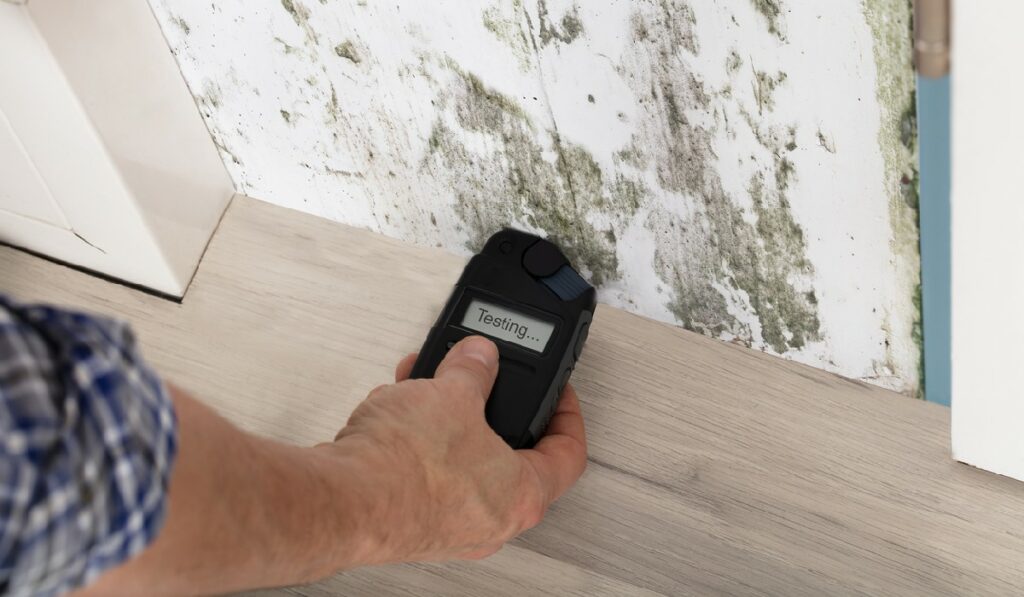A Comprehensive Guide To Checking the Moisture Content of Wood Before Your Build

Building a wooden structure is no simple task. It requires careful consideration and planning, as well as knowledge of woodworking techniques. One aspect of woodworking that is often overlooked is the moisture content of the wood. This is absolutely essential to ensure the stability of a woodworking project, as wood is prone to movement and expansion when exposed to moisture.
In this post, we’ll provide a step-by-step guide for checking the moisture content of wood before your build. We’ll also go over the different methods of measuring moisture, as well as the best practices for protecting your wood from moisture. Armed with this knowledge, you can rest assured that your next wood project will be as stable and durable as possible.
Wood Moisture Testing
What Is Moisture Content?
Moisture content (MC) is the measure of how much water a piece of wood contains compared to its oven-dry weight. In other words, it is the ratio of water weight versus dry weight. Oven-dry weight is determined by heating the sample at a temperature over 100º C until its weight does not change anymore, which indicates that all water has been expelled from the sample. The results are measured as a percentage and referred to as oven-dry percentage (OD%).
Why Is Testing for Moisture Content Necessary?
Knowing the MC of wood before starting your build is important due to the potential hazards it can cause if ignored. Depending on the environmental conditions, such as relative humidity and temperature, wood can absorb or lose moisture which will impact its shape and size. If these levels are unbalanced, it could create a situation where either one side or multiple sides warp or crack from the pressure created by uneven shrinkage and swelling. Plus, any type of adhesive used within your build may not perform effectively due to a lack of adhesion caused by high levels of moisture contained in the material.
Wood Moisture Testing Methods
Non-destructive Testing
Non-destructive testing methods refer to any type of testing that does not require damage or destruction to the material being tested in order to get a result. The two common non-destructive methods are the electrical resistance method and the electrical conduction method.
Electrical resistance method
This method measures the electrical resistance between two electrodes placed in contact with each other when passed through a sample of wood. You might want to get a wood moisture meter for this method. The electrical resistance changes according to fluctuations in MC and provides an accurate result quickly with minimal disturbance to the material being tested.
Electrical conduction method
This method works by passing a low voltage alternating current between two closely placed electrodes on either side of a sample piece while mounted in a cup measuring vessel with an electrolyte solution. The output voltage fluctuates according to changes in MC and can provide more accurate results than electrical resistance measurements alone.
Destructive Testing
Unlike non-destructive testing which does not cause any permanent damage to the material being tested, destructive testing requires sampling to be carried out for accurate results to be obtained about MC levels within a sample piece of wood material. Two common destructive methods are oven-dry and vacuum-oven methods.
Oven-dry method
This method requires cutting off a small sample from a piece of material and weighing it before placing it into an oven set above 100º C for 24 hours until its weight remains constant (indicates all water has been removed). Once cooled down, re-weigh it again and divide that new figure by this original starting figure multiplied by 100. This will provide you with its oven-dry percentage (OD%). You can then use this figure to determine what MC level the material contains using special tables available online for specific types of woods like oak or pine.
Vacuum-oven method
Similar to oven-dry, the vacuum-oven method requires specialized equipment that can heat samples at high temperatures within an airtight chamber where almost no oxygen exists (replaces with nitrogen gas). It also applies vacuum pressure simultaneously to speed up drying time to obtain more precise results than oven drying alone. This is due to higher vapor pressures applied on materials resulting in up to 20% quicker drying times than conventional oven drying methods can achieve.
Conclusion
The key to success in any woodworking project is to be aware of your material’s moisture content. Knowing the moisture content before you begin your build can save you from costly mistakes and potential disasters in the future. By following the steps outlined in this guide, you can know how to test the moisture content of your wood and ensure that your build is structurally sound and durable.
